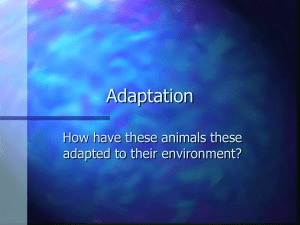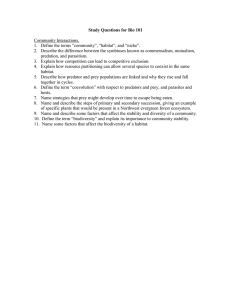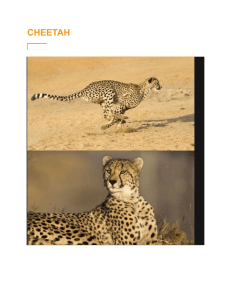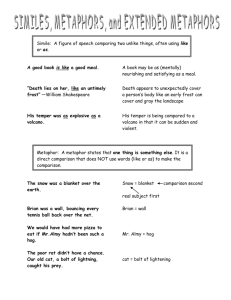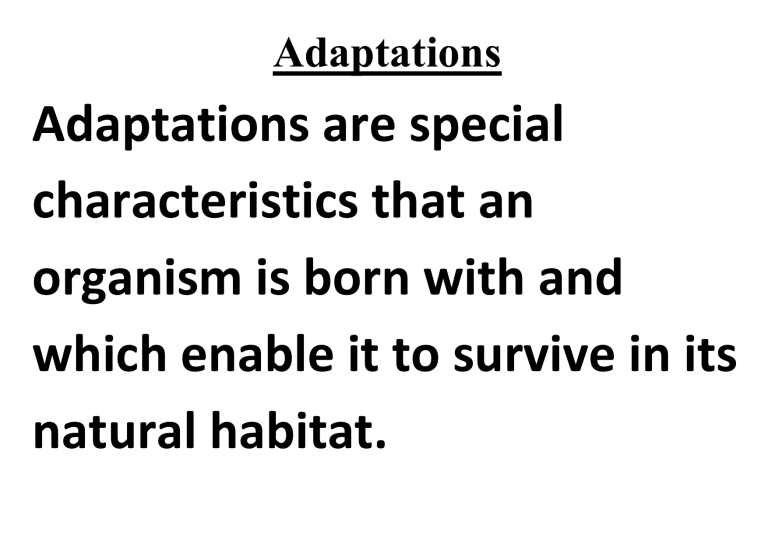
Adaptations Adaptations are special characteristics that an organism is born with and which enable it to survive in its natural habitat. CACTUS Cactus is a type of plant that can store large amounts of water and survive in extremely hot and dry habitats. There are around 2000 different species of cactus that differ in size, shape, color and type of habitat. Cacti can survive from 15 to 300 years, depending on the species. CAMEL Two rows of long eyelashes of the camel, protect against blowing sand and the sun Thick leathery patches on knees protect the camel from getting burn when it kneels on the hot desert. Nostrils can be close help the camel blowing out sand Thick fur and under wool of a camel, Provide warmth during cold desert nights and insulation against daytime heat Long strong legs help camels carry heavy loads over long distances and keep its body further away from the hot sand KANGAROO A kangaroo can cool itself off by licking its paws and rubbing them on its chest. Kangaroos have very large tendons in their hind legs which act as "springs". The springing motion uses less energy, so kangaroos are able to jump for long distances. Kangaroos have very long and strong tails for balance. The Eyes of the kangaroo are very far apart allowing them to see beside themselves and see subtle movements from far away. GIRAFFE Giraffes' famously long necks allow them to browse leaves off the tops of grassland trees, helping them avoid food competition from other herbivores The giraffe's patterned spots and light tan to dark brown coloring help camouflage the animal in the grassland environment. Giraffes acquire much of their water needs from food and from morning dew. They are also able to go for long periods without water and can gulp water quickly when needed. The dark coloring of the giraffe's tongue helps protect it from the harsh savanna sun. CHEETAH One physical adaptation of the cheetah is that it can run really fast. It can go from 0 to 60 miles per hour in 3 seconds. Another physical adaptation of the cheetah is its great eyesight to see prey from far away. CHAMELEON It has the ability to camouflage to fit its environment Chameleons can see in both visible and ultraviolet light. Chameleon eyes have a 360-degree arc of vision and can see two directions at once. It has Ballistic-sticky, tongues that are 1.5-2 times the length of their body which its uses to catch preys. OWL Its sharp talons help the owl to grip onto the post. All owls have large eyes, equipping them with good eyesight in both dark and light. It has a flexible neck which allows it turns its head almost 360 degrees. SHARK It has six senses on humans. The sixth sense helps its detect electricity activities in all animals serving as its prey. Its sense of smell is greatly high. Strong teeth for tearing and crushing. Their fins (especially caudal fin) have special shapes and sizes that allow them to move quickly through the water. KAOLA It has sharp claws for climbing and gripping trees. Its thick fur provides a cushioning effect, while sitting on trees and also protect them from extreme temperature variation. BAT Bats are mostly nocturnal animals. This means that they sleep during the day and are active at night. They use a special adaptation called echolocation. This is when they let out a very high pitched sound. The sound waves travel through the air, and if they come in contact with an object the sound waves bounce off and return to the bat. ALLIGATOR Gators have a very powerful tail to propel its way through water. They have tough, armoured skin which helps it puts regulate temperature weight on its prey. Gators can camouflage very well in water as a log of wood to deceive its prey. They also do the "death roll" to help break apart their prey. EAGLE An eagle's wings allows it’s to fly fast and so gracefully. An eagle's retina has five times more lightsensitive cells than a human's retina. It has Sharp talons to grip its prey firmly. Eagles have very sharp and pointed beaks which it often uses to grab prey with. POLAR BEAR Polar bears are very strong swimmers. They have thick furs for regulating body temperature. They have thick furs on the paws for grip on slippery surface. Sharp paws for tearing its preys.
